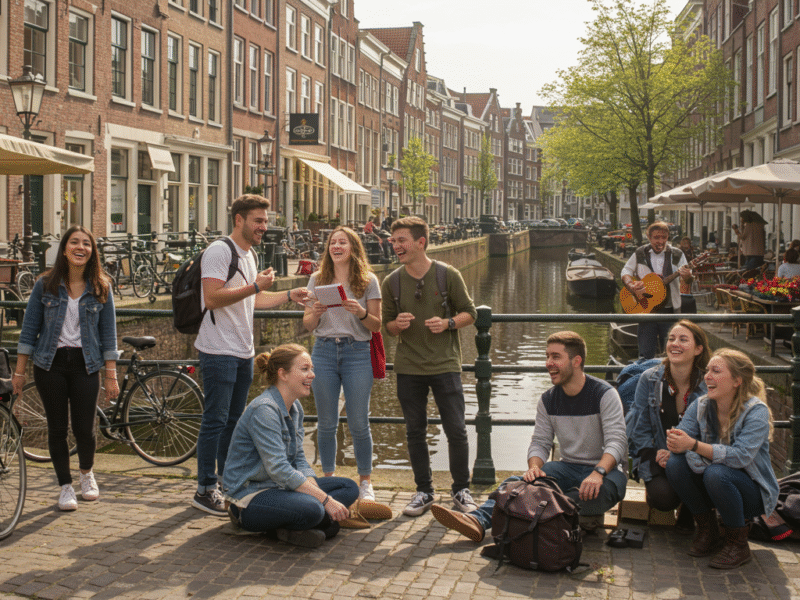Imagine wandering through sun-drenched plazas in the morning, then diving into a lecture hall buzzing with ideas from around the world by afternoon – that’s the magic of Europe’s standout cities for students and young explorers. Europe has always been a magnet for those chasing adventure on a budget, blending world-class education with endless opportunities for fun and discovery. Whether you’re packing your bags for a semester abroad or a backpacking trip with friends, these cities offer affordable living, vibrant cultures, and experiences that stick with you long after you head home. From historic gems to modern hubs, I’ve rounded up the best ones based on what makes them perfect for young folks – think low costs, lively student scenes, easy transport, and tons of things to do without breaking the bank.
In this guide, we’ll dive into why these places stand out, sharing tips on student life, must-see spots, and how to make the most of your time there. Europe isn’t just about postcards; it’s about real connections, late-night chats in hostels, and finding yourself in unexpected ways. Let’s jump in and explore the cities that top the list for students and young adventurers alike.
Berlin, Germany: The Ultimate Hub for Creativity and Affordability
Berlin hits that sweet spot where history meets hipster vibes, making it a dream for students and young travelers who want depth without the high price tag. As one of Europe’s most affordable capitals, you can snag a dorm bed for under 20 euros a night or rent a shared apartment for around 400 euros a month. The city’s universities, like Humboldt University and Freie Universität, draw international students with top-notch programs in arts, tech, and social sciences, often with low or no tuition fees for EU folks and reasonable costs for others. But let’s dig a bit deeper into what makes Berlin tick for the under-30 crowd.
First off, the cost of living here is a game-changer. Groceries? You can stock up at Lidl or Penny for pennies on the euro, whipping up meals that fuel your all-nighters without denting your wallet. And speaking of nights, Berlin’s nightlife is legendary – not just the clubs, but the underground scene of pop-up raves and poetry slams in forgotten bunkers. I remember my first time stumbling upon a free techno set in an old power plant; it was like the city’s pulse syncing with yours. For students, the Semesterticket gives unlimited public transport for about 20 euros a month, meaning you can hop from a philosophy seminar in Mitte to a graffiti tour in Neukölln without a second thought.
What about the academic side? Berlin’s unis aren’t just about degrees; they’re hubs for innovation. Think startup incubators where you might code your app idea next to a PhD candidate debating quantum ethics. International students make up nearly 20% of the enrollment, so language barriers melt away – English is everywhere, and tandem language partners are a dime a dozen. Beyond classes, volunteer gigs at refugee centers or environmental collectives let you give back while padding your CV.
For young travelers, the real joy is in the unplanned moments: cycling along the Spree River at dusk, sharing stories with Aussies and Argentinians in a Kreuzberg kebab joint, or losing hours in the Pergamon Museum’s ancient gates (student entry: free on Thursdays). Safety is solid, though like any big city, stick to well-lit paths after dark. Berlin isn’t perfect – winters are gray and brutal – but that grit builds character. It’s the city that says, “Figure it out,” and in doing so, hands you the tools to thrive anywhere.
Expanding on the cultural immersion, consider the festivals. Summer’s Lollapalooza Berlin packs global acts into Olympic Stadium for tickets under 100 euros, while Karneval der Kulturen turns streets into a multicultural feast with dances from Asia to Africa. Food-wise, beyond currywurst, vegan spots like Kopps serve hearty bowls for 8 euros, catering to every diet. If you’re studying sustainability, Berlin’s urban farms and zero-waste shops are living labs. In short, this city doesn’t just host your journey; it co-authors it, leaving you bolder, broader, and broke in the best way.
Amsterdam, Netherlands: Canals, Culture, and Chill Vibes
Amsterdam whispers adventure with its winding canals and bike-filled streets, pulling in young souls eager for a mix of relaxation and excitement. Known for its progressive spirit, this city is a top pick for students thanks to universities like the University of Amsterdam, where English-taught courses in business, psychology, and environmental studies attract globals. Tuition for non-EU students hovers around 8,000 to 15,000 euros a year, but scholarships abound, and part-time jobs in cafes or tourism help cover costs. The real draw, though, is how effortlessly it weaves learning with living.
Picture pedaling to class past houseboats bobbing in the Herengracht, your backpack stuffed with notes on urban planning – ironic, since the city itself is a masterclass in it. Housing can be tricky (hello, waiting lists), but platforms like Kamernet hook you up with shares for 500-700 euros, often in quirky converted warehouses. Once settled, the student ID unlocks perks: half-price at the Van Gogh Museum, where swirling skies inspire your essays, or free entry to the Nemo Science Museum for hands-on experiments.
Young travelers, don’t sleep on the outskirts. A quick train to Zandvoort Beach means sand between your toes and volleyball with locals for zero cost. Back in town, the Jordaan neighborhood’s cheese markets and live buskers create spontaneous soundtracks to your wanders. Nightlife ranges from mellow jazz at Bimhuis (student nights: 10 euros) to the thump of Paradiso, a former church turned concert hall. And yes, the coffee shops – approach with curiosity, not expectation; they’re more about chill chats than anything else.
What sets Amsterdam apart for personal growth is its openness. LGBTQ+ events like Amsterdam Pride turn canals into rainbow rivers of acceptance, while bike co-ops teach repair skills alongside Dutch phrases. Food? Herring stalls for 3 euros or Indonesian rijsttafel feasts shared family-style. Winters bring cozy hygee-like evenings in brown cafes, nursing hot chocolate while debating global issues. Safety is top-tier, with community policing that feels like neighborly chats. Amsterdam isn’t a destination; it’s a gentle nudge to explore your edges, emerging more balanced and bold.
To really embed yourself, join a canal cleanup or a philosophy walking tour – free through uni clubs. The city’s sustainability push, from bike superhighways to vertical farms, aligns perfectly with eco-conscious youth. If you’re into film, the International Documentary Festival screens indie gems for peanuts. In essence, Amsterdam gifts you freedom: to learn, love, and laugh without the weight of worry.
Prague, Czech Republic: Fairy-Tale Charm on a Shoestring Budget
Prague feels like stepping into a storybook, with its gothic spires and fairy-tale bridges captivating students and young wanderers who crave magic without the massive bill. As one of Europe’s cheapest capitals, it’s ideal for budget travel – think beers for a euro and hearty meals like goulash for under five. Charles University, one of the oldest in Europe, offers affordable programs in medicine, humanities, and law, with tuition often below 5,000 euros for internationals. Yet, it’s the blend of whimsy and wisdom that keeps you hooked.
Start your days with a coffee in a Kafka cafe, pondering existentialism before a literature lecture – the writer’s spirit lingers in every corner. Student dorms in Vinohrady run 150-300 euros, complete with communal kitchens where midnight dumpling sessions forge lifelong bonds. Public transport? A monthly pass for 10 euros glides you on trams that rattle like time machines past baroque facades.
For travelers, the magic multiplies. Climb Petřín Hill for a mirror maze and rose gardens, all gratis, or hunt astronomical clocks in hidden alleys. Vyšehrad Fortress offers riverside picnics with views that rival any postcard. Evenings? Dive into absinthe bars or the cross-club, a boat-turned-rave with steampunk flair for 5 euros entry. Food adventures include trdelník stalls twisting sweet dough around your dreams – literally, stuff it with ice cream for 4 euros.
Prague’s student scene pulses with energy: film fests like Febiofest screen Czech new wave for free, while hiking clubs trek to Bohemian forests on weekends. History buffs, the Jewish Quarter’s synagogues whisper tales of resilience, entry under 10 euros. Safety is high, but elbow through crowds at the Astronomical Clock wisely. Winters coat everything in snow-dusted wonder, perfect for mulled wine markets.
Deeper still, Prague nurtures creativity. Art collectives in Žižkov host open mics, and puppet theaters revive folklore with a modern twist. Vegan spots like Lehká Hlava serve up enlightened eats affordably. It’s a city that romances your intellect, turning cobblestones into classrooms and spires into sparks of inspiration. Leave with a fuller heart and emptier pockets – the good kind.
Barcelona, Spain: Sun, Sea, and Vibrant Student Scenes
Barcelona bursts with color and life, drawing students and young travelers with its beaches, architecture, and endless fiesta spirit that keeps the energy high year-round. Home to universities like Universitat de Barcelona and Pompeu Fabra, it shines in fields like design, tourism, and biotech, with tuition around 1,000-3,000 euros for EU students and a bit more for others. The Mediterranean climate means outdoor study sessions are the norm, but let’s unpack why this coastal gem feels like home from day one.
Envision sketching Gaudí’s organic curves in La Pedrera while munching a bocadillo for 3 euros – architecture class, Barcelona style. Shared flats in Eixample go for 400-600 euros, buzzing with flatmates from Madrid to Mexico. The T-10 metro card (10 rides for 11 euros) zips you from Sagrada Família seminars to Sants station for weekend getaways.
Young explorers, the beach is your backyard. Gràcia’s festivals turn plazas into open-air theaters with giant puppets and paella pots – all free. Montserrat’s monastery hike rewards with black Madonna views and monk chants echoing your thoughts. Night falls, and El Raval’s bars pour vermut for pennies, leading to salsa nights where steps are learned on the fly.
Student life here is a fiesta of connections: language tandems at the uni cafe, volunteer beach cleanups, or hackathons birthing apps for sustainable tourism. Food markets like La Boqueria overflow with jamón and fresh juices for under 5 euros. Inclusivity? Pride parades rival Carnival, and halal tapas spots welcome all. Though pickpockets lurk, common sense keeps you golden.
Barcelona’s soul lies in its layers – Roman ruins under Gothic arches, modernist whimsy amid medieval might. Join a flamenco workshop for 15 euros or surf lessons at Nova Icària. Summers sizzle with Sonar Festival’s electronic beats, winters mild for olive grove day trips. It’s the city that infuses passion into your pursuits, teaching you to dance through challenges with a smile.
Lisbon, Portugal: Hills, History, and Hip Neighborhoods
Lisbon climbs its seven hills with a warmth that welcomes students and young travelers seeking authentic vibes and ocean breezes. Universities such as Universidade de Lisboa offer strong programs in engineering, arts, and marine sciences, with low tuition – often under 1,000 euros for EU nationals and affordable for internationals. The city’s laid-back pace suits those balancing studies with exploration, but peel back the azulejo tiles, and you’ll find a tapestry of tales waiting to unfold.
Ride the iconic 28 tram (3 euros) to classes overlooking Tagus sunsets, your notebook filling with notes on postcolonial lit. Residences in Chiado average 300-500 euros, with rooftop views that make studying feel like a privilege. The Viva Viagem card covers buses and trains for pocket change, linking campuses to Sintra’s fairy-tale palaces.
Wanderers, Alfama’s labyrinths hide fado houses where soulful songs pierce the night for 10 euros, including sardine snacks. LX Factory’s warehouses pulse with street art galleries and craft breweries – free entry, endless inspiration. Day trips to Belém’s pastéis de nata (1 euro each) pair perfectly with tower climbs and monument musings.
For students, the vibe is collaborative: surf clubs at Carcavelos Beach double as social hours, while tech meetups in Incubadora spark startup dreams. Markets like Feira da Ladra hawk vintage finds Sundays. Diversity thrives – Cape Verdean beats mix with Brazilian samba in Bairro Alto bars. Safety’s reassuring, with community spirit trumping solo worries.
Lisbon’s history, from Age of Discoveries echoes to 1755 quake rebirths, mirrors personal reinvention. Vegan eateries like Zen serve zen bowls affordably, and yoga on the Tagus fosters mindfulness. Festivals like Santos Populares fill June with sardine grills and folk dances. It’s a city that hugs you close, whispering, “Saudade is sweet,” as you chase horizons.
Budapest, Hungary: Thermal Baths and Bohemian Energy
Budapest steams with thermal baths and grand architecture, offering students and young travelers a blend of relaxation and revelry that’s hard to beat on a budget. Eötvös Loránd University and others provide excellent courses in economics, IT, and film, with tuition often below 4,000 euros. The city’s split by the Danube – Buda’s calm hills versus Pest’s lively buzz – gives variety, but it’s the thermal therapy for the soul that seals the deal.
Soak in Rudas Baths’ Ottoman domes post-lecture (weekend entry: 15 euros), emerging renewed for group projects on Central European politics. Dorms in District VII cost 200-400 euros, kitchens alive with goulash experiments. The BKK pass (monthly: 10 euros) ferries you across bridges like living postcards.
Adventurers, Fisherman’s Bastion’s turrets frame Parliament views for free, while Margaret Island’s ruins host rose gardens and musical fountains. Ruin pubs? Szimpla Kert’s bathtubs-turned-seating pour pálinka for 2 euros amid upcycled art. Hike Gellért Hill for liberty statues and city panoramas at dawn.
Student circles buzz with film fests at Urania, entry under 5 euros, or Danube kayaking clubs blending adventure with ecology chats. Central Market’s lángos stalls fuel bargain hunts. Vegan hubs like Napfényes serve plant-based chimney cakes. History’s heavy – Shoes on the Danube memorial tugs heartstrings – yet resilient, with Jewish quarter revivals.
Budapest’s bohemia inspires: poetry slams in Gozsdu Courtyard, craft markets at Vörösmarty Square. Summers splash with Danube Festival cruises, winters warm with Christmas markets’ mulled wine. It’s a city of contrasts that smooths your edges, bathing you in warmth and wonder.
Vienna, Austria: Classical Elegance Meets Modern Youth
Vienna waltzes into your heart with its imperial palaces and coffee houses, perfect for students and young travelers who appreciate refinement without stuffiness. The University of Vienna, one of Europe’s oldest, excels in music, philosophy, and sciences, with minimal fees for EU students. The city’s clean, efficient vibe makes it easy to settle in, but beneath the Strauss strains lies a youthful undercurrent ready to sweep you up.
Savor sachertorte in a Freud cafe between psych seminars, your mind whirling with id and ego. Shares in Währing run 500-700 euros, balconies overlooking vineyards. The Wiener Linien annual pass (student: 150 euros) whisks you to Belvedere’s Klimt kisses.
Explorers, Schönbrunn’s maze gardens twist free adventures, while Prater’s haunted house thrills for 5 euros. Secession Building’s gold leaf whispers art nouveau secrets. Evenings? Standing-room opera at Staatsoper (4 euros) vibrates with Verdi.
Uni life hums with orchestra auditions and debate clubs in baroque halls. Naschmarkt’s stalls hawk kebabs and knödel for 6 euros. Vegan cafes like Tian offer elegant eats. Safety’s impeccable, parks like Volksgarten cradling quiet reads.
Vienna’s fusion shines: tech parks in former factories host hack nights, summer’s Donauinselfest rocks gratis. It polishes your poise, blending heritage with horizon-expanding hops.
Copenhagen, Denmark: Hygge, Bikes, and Nordic Cool
Copenhagen wraps you in hygge – that cozy Danish feeling – while delivering cutting-edge design and sustainability for students and young travelers. Universities like the University of Copenhagen lead in environmental studies and biotech, with free tuition for EU/EEA students and scholarships for others. The bike culture keeps everything accessible and eco, but it’s the seamless blend of cool and comfort that captivates.
Cycle to lectures past wind turbines, notebook brimming with green policy ideas. Kollegiums (student halls) cost 400-600 euros, saunas included for post-study steams. The City Pass (30 days: 30 euros) covers bikes, buses, trains.
Wanderers, Nyhavn’s pastel facades frame canal kayaks (rent: 10 euros/hour), Christiania’ s free-spirited stalls sell handmade vibes. Superkilen Park’s global mosaic sparks cultural chats.
Students thrive in co-op dinners and design workshops at DIS. Reffen’s food trucks dish smørrebrød for 8 euros, vegan twists aplenty. Pride’s rainbow runs celebrate equality.
Copenhagen’s calm empowers: forest bathing in Dyrehaven, startup pitches at Ballsport. Though pricier, value in quality – fresh air, fresh ideas – repays tenfold.
Paris, France: Romance, Art, and Intellectual Buzz
Paris sparkles with Eiffel Tower lights and Seine River cruises, enchanting students and young travelers with its timeless allure. Sorbonne and other unis shine in humanities, fashion, and business, with low tuition around 200-400 euros for undergrads. The city’s intellectual cafes once hosted Hemingway; now they’re study spots, but Paris’s pulse is in its poetic push-pull of glamour and grit.
Debate Sartre over espresso near Pantheon classes, baguette in hand (2 euros). Latin Quarter rooms: 500-800 euros, creaky floors full of charm. Navigo pass (monthly: 85 euros) navigates metros like veins.
Picnickers, Champ de Mars lawns host cheese and wine (budget: 10 euros). Marais galleries gush street art gratis. Canal Saint-Martin’s bars buzz with boules games.
Uni networks knit global threads: film clubs at mk2, bakery shifts for pocket money. Marchés d’Aligre yield 3-euro tartes. Diversity delights – Chinatown dim sum to Maghrebi tagines.
Paris provokes passion: Nuit des Musées free nights, Seine swims in summer. It sculpts your sophistication, one stolen glance at a time.
London, United Kingdom: Diversity, Dynamism, and Endless Opportunities
London pulses with global energy, making it a powerhouse for students and young travelers chasing dreams in a melting pot. UCL and Imperial College lead in everything from medicine to media, though tuition for internationals hits 10,000-30,000 pounds; scholarships help. The multicultural neighborhoods fuel innovation, but London’s labyrinth of lives is what lingers.
Tube to LSE economics, emerging to Brick Lane curry (5 pounds). Zone 2 shares: 600-900 pounds, tube tales included. Oyster card (daily cap: 8 pounds) unlocks the sprawl.
Roamers, South Bank’s graffiti walls frame Thames views, Borough Market’s stalls tempt with 4-pound falafel. Shoreditch street art tours: free self-guided.
Students network at pub quizzes, volunteer in community gardens. Notting Hill’s carnival shakes souls. Job cafes abound for barista gigs.
London’s mosaic motivates: Tate Modern’s turbines whirl ideas, rooftop yoga in Greenwich. Hustle hones you, diversity deepens you.
Madrid, Spain: Passion, Parks, and Party Nights
Madrid thrives on siestas and late dinners, suiting students and young travelers who love lively rhythms. Complutense University excels in languages and journalism, with affordable fees. The sunny weather encourages outdoor life, but Madrid’s heartbeat is in its unhurried urgency.
Siesta after lit class, then Retiro rowboats (6 euros). Malasaña pads: 400-600 euros, flamenco echoes. Abono metro (10 trips: 12 euros).
Parque del Buen Retiro’s crystal palace gleams free, Prado’s Goyas discounted. Malasaña’s vinyl shops spin indie nights.
Clubs host intercambio languages over cañas (2 euros). Vegan Vida’s bowls nourish. San Isidro’s chotis dance streets alive.
Madrid’s fire forges friendships, siesta to fiesta.
Krakow, Poland: History, Heart, and Hidden Gems
Krakow enchants with medieval squares and poignant history, affordable for students and young souls. Jagiellonian University, ancient and prestigious, offers programs in history and sciences cheaply. But Krakow’s quiet strength whispers through its stones.
Wawel lectures overlook Vistula, pierogi picnics (3 euros). Dorms: 200-400 euros, folk song sing-alongs. MPK pass (monthly: 50 PLN).
Kazimierz synagogues stir souls (entry: 5 euros), Planty’s ring road rambles free. Alchemia bar’s jazz flows.
Uni orchestras play Chopin, Nowa Prowincja’s theater ignites. Vegan Greentogo’s bowls heal. Wianki solstice crowns float wishes.
Krakow’s heart heals, history humbles.
Stockholm, Sweden: Islands, Innovation, and Nature Escapes
Stockholm spreads across islands, blending urban cool with nature for students and young travelers. Karolinska Institute leads in health sciences, free for EU. The archipelago invites exploration, but Stockholm’s subtle sparkle is in its sustainable soul.
Ferry to KTH engineering, fika breaks (coffee + bun: 4 euros). Studentbostäder: 400-700 SEK, sauna shares. SL access (monthly: 900 SEK).
Gamla Stan’s alleys hide Nobel museums (free youth), Djurgården’s kayaks (rent: 100 SEK). Södermalm’s vintage vibes call.
Roskilde fest’s mud dances bond. Vegan Hermans’ buffets satisfy. Midsummer’s maypoles weave magic.
Stockholm’s serenity sparks, equality elevates.
Munich, Germany: Beer Gardens, Bavarian Charm, and Tech Hubs
Munich mixes Oktoberfest fun with serious studies, attracting students to LMU in engineering and business. Affordable living, with beers in gardens cheap. But Munich’s precision pairs with play, crafting confident creators.
Englischer Garten seminars, pretzels (2 euros). WGs: 400-600 euros, bike basements. MVV pass (monthly: 30 euros).
Eisbach surfers wow free, Viktualienmarkts cheeses tempt. Augustiner Keller’s benches host tales.
TUM hackathons innovate, vegan Prinz Myshkins delights. Frühlingsfest’s oompah lifts spirits.
Munich’s charm challenges, warmth welcomes.
Europe’s cities for students and young travelers offer more than sights – they shape who you become. From Berlin’s grit to Stockholm’s serenity, each spot invites growth on a budget. Pack light, stay open, and let the adventures unfold. Whether you’re enrolling for a degree or just passing through with a Eurail pass, these places promise memories that money can’t buy. Dive in, make mistakes, and emerge transformed – that’s the European way.
For more on student city rankings, check out the QS Best Student Cities. Planning a trip? Visit European Best Destinations for tips.
Recommendations:
- Exploring Hidden Gems: Underrated Travel Destinations
- The Best Time to Travel to Popular Tourist Spots
- Best Travel Apps Every Traveler Should Use











